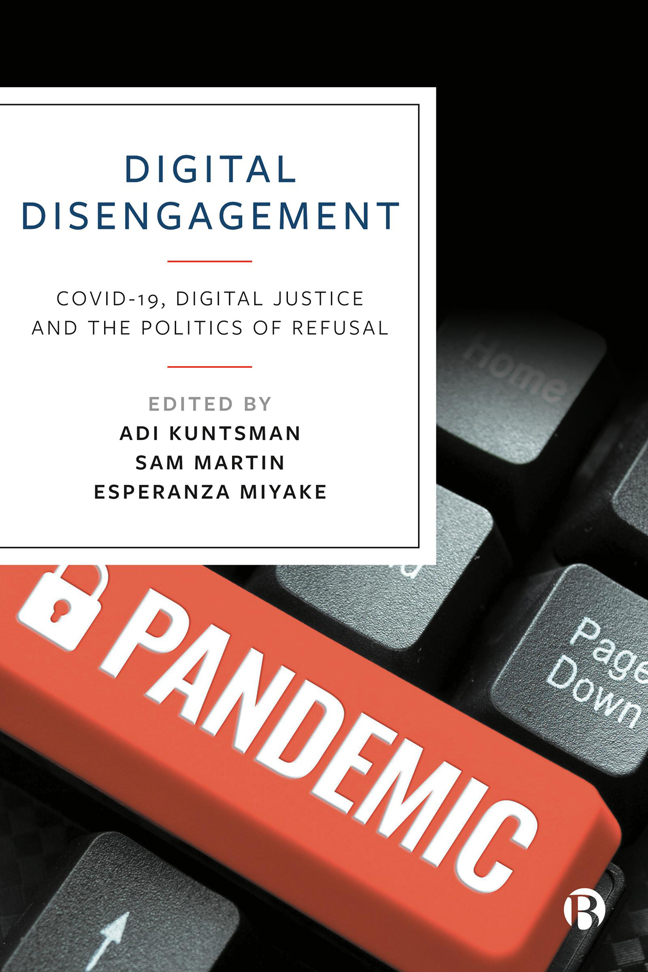Book contents
- Frontmatter
- Contents
- Notes on Contributors
- Introduction
- One En/forcing the Tokyo 2020 Olympics: The Racialization of Digital Engagement and Digital Solutionism
- Two Digital Engagements and Work–Life Balance in Creative Labour
- Three ‘#RoeVsWadeOverturned: Any Idea How Fast Your #PeriodtrackingApp Can Lead To Jail?’: Digital Disengagement and the Repeal of Roe vs Wade
- Four #SnailMailRevolution: The Networked Aesthetics of Pandemic Letter-Writing Campaigns
- Five Data Minimalism and Digital Disengagement in COVID-19 Hacktivism
- Six Digital Solutionism Meets Pandemic Imaginaries
- Seven State Violence, Digital Harms and the COVID-19 Pandemic: Imagining Refusal, Resistance and Community Self-Defence
- Epilogue: Digital Disengagement – Questions of Pandemic and Post-Pandemic Digitalities
- Index
Four - #SnailMailRevolution: The Networked Aesthetics of Pandemic Letter-Writing Campaigns
Published online by Cambridge University Press: 25 January 2024
- Frontmatter
- Contents
- Notes on Contributors
- Introduction
- One En/forcing the Tokyo 2020 Olympics: The Racialization of Digital Engagement and Digital Solutionism
- Two Digital Engagements and Work–Life Balance in Creative Labour
- Three ‘#RoeVsWadeOverturned: Any Idea How Fast Your #PeriodtrackingApp Can Lead To Jail?’: Digital Disengagement and the Repeal of Roe vs Wade
- Four #SnailMailRevolution: The Networked Aesthetics of Pandemic Letter-Writing Campaigns
- Five Data Minimalism and Digital Disengagement in COVID-19 Hacktivism
- Six Digital Solutionism Meets Pandemic Imaginaries
- Seven State Violence, Digital Harms and the COVID-19 Pandemic: Imagining Refusal, Resistance and Community Self-Defence
- Epilogue: Digital Disengagement – Questions of Pandemic and Post-Pandemic Digitalities
- Index
Summary
Introduction
Amid the social distancing, doom-scrolling and mounting Zoom fatigue that accompanied the COVID-19 pandemic in the US, people reached for pens, paper and postage stamps. Despite their long legacy, handwritten letters are often discussed as a novelty when social connection seems just a text or video call away. Nonetheless, the pandemic brought on sympathy card shortages and think pieces on the benefits of sending letters for a pandemic-addled, computer-saturated sociality. Penpal programmes blossomed, and, according to a survey by the US Postal Service, people reported sending more personal mail than they had before (US Postal Service, 2021). Even as the pandemic unevenly altered online social connection for many (Nguyen et al, 2020), the proliferation of handwritten letters presented an alternative to digital modes of social interaction and a supposed escape from the connective commodification engendered in platform economies (van Dijck, 2013). After all, media scholars have long argued that analogue epistolatory technologies invite intimacy and social presence because of their textualized and material qualities, not in spite of them (Milne, 2010).
Beyond the cultural salience of letters, however, the popularity of hashtags about letter writing also grew on the same social media platforms that handwritten letters circumvent. Letterwriting aesthetics trended on Instagram long before COVID-19, but, within the altered climates of pandemic digitalities, their growth takes on new meaning. People shared images of letters they received and others they planned to send using hashtags such as #SnailMailRevolution and #SendLove. More telling, however, are the dozens of popular letter-writing campaigns that sprung up to combat pandemic social isolation and engage political causes, encouraging participants to share their missives on Instagram. Campaign communications and news articles discuss letter writing as a means to disengage from the digital and reconnect in novel yet nostalgic ways, which, according to journalist Tanya Basu (2020) ‘makes snail mail possibly more powerful than email or text’. The New York Times reported that letter writing is ‘getting people through this time’ (Danovich, 2020), while the founder of a viral pandemic penpal project explained, ‘There is something about [letter writing] being disconnected from this immediacy of online that feels enchanting to people’ (Cooper, 2021).
- Type
- Chapter
- Information
- Digital DisengagementCOVID-19, Digital Justice and the Politics of Refusal, pp. 83 - 102Publisher: Bristol University PressPrint publication year: 2023



